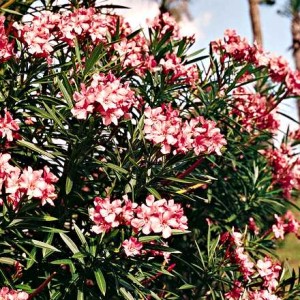
|
|
Oleander
- Nerium Oleander
|
Olenader
- Nerium Oleander
The oleander (Nerium Oleander) is a plant of the Dogbane family - Apocynaceae -
family.
It is an evergreen shrub reaching up till 4 m. It shows erect
stems, plenty of latex. Lanceolate leaves, similar to those of the sweet
bay, opposed, hard to the tact, with short petiole. It produces rosy flowers till 4
cm. Its fruits remember those of the beans, but they are much bigger dark
brown. Inside these pods they contain seeds provided with feathery
plumes
It is native from Europe and Asian Middle
East, although it can be found like an ornamental plant in many parts of the
world.
Nerium oleander is native to the Mediterranean region and was the only kind of Oleander known in Europe until 1683 when Rheede Tot Drakenstein introduced in Holland a cultivated oleander from
India.
The Oleander, as this
plant is commonly called, grows in sandy and calcareous places with exhibition to full
sun, especially in the beds of the Mediterranean riverbeds that remain dry most of the year
Along the whole summer it can produce very showy flowers
that, in very mild climates can continue until mid autumn. The flowers are very
big, funnel shaped, with colors that can vary from the red or rose to the
violet, the salmon or the pure white. They usually have a single line of
petals, generally having eight, but we have other species that present two
lines.
Oleander is a poisonous plant. All parts of
this plant are poisonous if eaten. The active ingredients are extracted from the
leaves. There have been reports of poisoning and death from ingestion of
oleander, oleander leaf tea, and some of its extracts. Even a small amount of oleander can cause fatal respiratory paralysis and cardiac
effects. One of the substances in oleander that causes the dangerous effects on the heart is called
oleandrin. Because of these dangerous effects, oleander should not be
used.
The
fumes from a burning Ôleander is still very hazardous. Steer clear of
the fumes and never use the branches as firewood!
Although this plant is
poisonous, derivatives from oleander have been used for centuries as herbal
medicine. Historical records show that the Mesopotamians, in the 15th century
BC, believed in the healing properties of oleander. The Babylonians used a mixture of oleander and licorice to treat
hangovers. Pliny, the Elder of ancient Greek, wrote about the
appearance, as well as the poisonous and beneficial properties, of
oleander. Arab
physicians first used oleander as a cancer treatment in the 8th century
AD.
Nowdays there is no scientific evidence that oleander is effective in treating cancer or any other
disease. However, even though oleander is poisonous, heavily diluted oleander preparations have been promoted to treat a variety of conditions including muscle
cramps, asthma, corns, menstrual pain, epilepsy, paralysis, skin
diseases, heart problems, and cancer. It has also been used in folk remedies as an
insecticide.
Source:
http://www.botanical-online.com/floradelfaangles.htm
http://sciweb.nybg.org/science2/Onlinexhibits/citrus.htm
http://www.cancer.org/docroot/ETO/content/
ETO_5_3X_Oleander_Leaf.asp?sitearea=ETO
